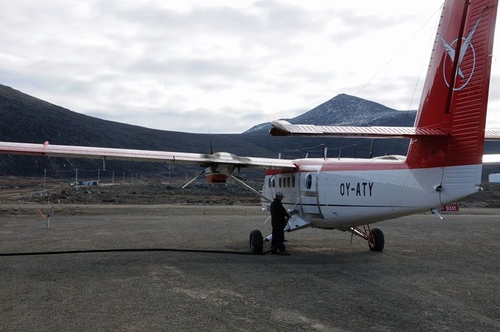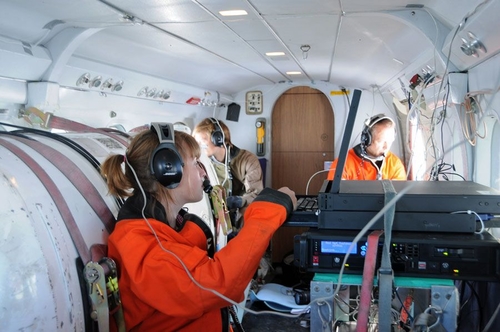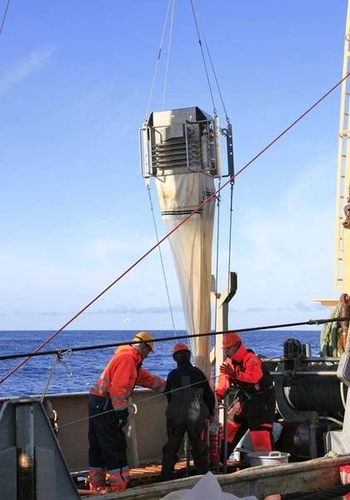New knowledge about whales and seabirds in Davis Strait Published 29.10.2009

For the first time, the respective distributions of seabirds, whales and their food during their autumn migration in the Baffin Bay and the Davis Strait have been mapped simultaneously.
This has been possible due to close collaboration between scientists from the National Environmental Research Institute (NERI), Aarhus University in Denmark and the Greenland Institute for Natural Resources (GINR), who undertook this comprehensive study in September from a research vessel and an airplane, respectively. The Canadian Wildlife Service is also a partner in the study.
With the combined effort, the distribution of seabirds and whales could be studied on a larger scale, thus documenting the present-day situation. The results will contribute to a Strategic Environmental Impact Assessment in relation to oil exploration in this area. Funding for the various research activities has been provided by oil companies who have been granted oil exploration licenses. The Bureau for Minerals and Petrol (BMP) in Nuuk is in charge of administration of these funds.
Canadian authorities granted permission to land
A Twin Otter from Greenland Air, equipped with a camera system and computer equipment, flew with four observers along selected east-west transects between Greenland and Nunavut (Canada). The longest distance was 650 km, made possible by the Canadian authorities granting permission to land at Clyde River and Qikiqarjuaq.
“During the air surveys we could identify some areas with large numbers of Thick-billed Murres and Little Auks”, said Lars Maltha Rasmussen, one of the scientists from GINR. “When the Thick-billed Murres leave their breeding grounds at the end of August, together with the young ones which cannot yet fly, they perform what is known as a ‘swimming migration’. We also have data from the swimming migration based on satellite tracking of murres from three different colonies.,”
Large flocks of whales observed
Rikke Guldborg Hansen, GINR, was enthusiastic about the sightings they made during the air surveys. “Even though the weather was rather changeable, we have been lucky to have good conditions for most of the time. We have seen Pilot Whales in the open part of Baffin Bay, where they have not been observed before. We also observed a large group of Narwhals, approx. 350-500 animals, close to the Canadian coast.” The Bowhead Whale is another important species, which at this time of the year is found in Isabella Bay in Canada, the first reserve for Bowhead Whales globally. “We observed at least 50 Bowhead Whales in just 20 minutes of flying around in the bay”, said Rikke Guldborg Hansen.
Studies also from mairne research vessel
Simultaneously with the air surveys, scientists from NERI performed seabird observations and marine biological studies in the same area, using the Icelandic research vessel Bjarni Sæmundsson. Cruise leader Doris Schiedek, NERI, was highly satisfied with the results obtained. “We were able to observe seabirds, such as Thick-billed Murre or Little Auk, along various east-west transects. At the same time we could study the distribution of zooplankton and young fish, such as Arctic Cod, which are important food items for the seabirds and marine mammals. All this data will give us an improved understanding of the interactions between migration patterns of important seabirds and their food sources.”
Contact persons:
Lars Maltha Rasmussen, Greenland Institute for Natural Resources (GINR), Tel: +299 48 58 51, mail
Anders Mosbech, National Environmental Research Institute (NERI), Aarhus University, Denmark, Department for Arctic Environment. Tel: +45 4630 1934
Doris Schiedek, National Environmental Research Institute (NERI), Aarhus University, Denmark, Department for Arctic Environment. Tel: +45 4630 1962

Rikke Guldborg Hansen operating the advanced computer system during the air survey. Photo: Lars Maltha Rasmussen.

Collection of zooplankton samples from various water depths with a multi-net. Photo: David Boertmann.

